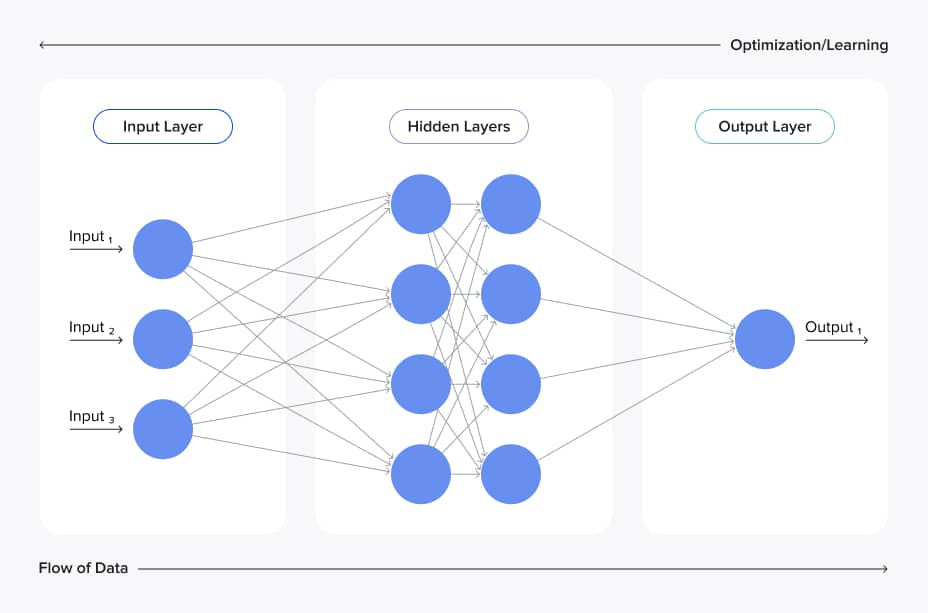By leveraging the self-organising, adaptive, and energy-efficient properties of these living neural systems, OI aims to create a new class of biohybrid computing platforms. These systems have the potential to perform information processing tasks in ways that differ fundamentally from conventional silicon-based architectures. As both a scientific and technological frontier, OI offers promising avenues for developing novel forms of cognition, learning, and decision-making within biological hardware.
In this article, we'll explore Organoid intelligence, an innovative advancement at the intersection of neuroscience, synthetic biology, and computer science.
- Organoid Intelligence (OI) leverages lab-grown brain organoids as biological substrates for computing and artificial intelligence (AI) applications.
- The Baltimore Declaration formally introduced Organoid Intelligence as an emerging field that integrates brain science, biology, engineering, computer science, and ethics.
- OI aims to develop energy-efficient, adaptive computing systems inspired by the human brain, potentially surpassing traditional silicon-based architectures in certain tasks.
- OI systems face significant challenges in scaling, maintenance, and understanding how they work.
The Baltimore declaration on organoid intelligence
In February 2022, a diverse group of researchers from neuroscience, engineering, bioethics, artificial intelligence, and synthetic biology convened for the first Organoid Intelligence (OI) Workshop, titled “Forming an OI Community,” hosted by Johns Hopkins University. The result of this multidisciplinary gathering was the Baltimore Declaration. This foundational document formally introduced the concept of organoid intelligence and called upon the global scientific community to explore its potential and implications. Drawing parallels with artificial intelligence, the declaration defines organoid intelligence as the use of human brain-based organoid cultures as computational and cognitive systems, highlighting their potential for advancing both scientific understanding and technological innovation.
Notably, the Baltimore Declaration emphasises the importance of addressing ethical considerations from the outset. It requires ongoing stakeholder engagement to ensure responsible research, particularly regarding the potential emergence of consciousness in organoids, the rights of cell donors, and the broader societal implications of integrating living systems into computational infrastructure. These concerns highlight the complexity of developing ethical, legal, and technical frameworks in tandem with scientific advancements.
By formalising organoid intelligence as a collaborative discipline, the Baltimore Declaration represents a significant milestone in biocomputing. It sets a visionary agenda for uniting experts across domains to advance OI in ways that are scientifically rigorous, ethically sound, and socially responsive. As the field continues to evolve, the declaration serves as both a manifesto and a roadmap for the responsible development of intelligence-in-a-dish technologies.
Comparison of artificial neural networks and organoid intelligence
Artificial Neural Networks (ANNs) and Organoid Intelligence (OI) represent two fundamentally distinct approaches to information processing. While both draw inspiration from biological neural systems, they diverge significantly in architecture, energy efficiency, and adaptability. This section provides a review of the significant differences only, excluding a detailed overview of all properties.
Artificial Neural Networks
- ANNs are mathematical models implemented on software or silicon-based hardware designed to simulate aspects of neuronal connectivity and learning.
- They rely on many layers of artificial neurones that adjust connection weights through algorithms such as backpropagation.
- Learning proceeds via backpropagation and gradient descent over large datasets, after which the network weights remain static unless an explicit retraining pass is invoked.
- Although modern GPUs and TPUs permit limited forms of data parallelism, their operation is fundamentally synchronous and deterministic, and they contain a discrete instruction set.
- ANNs require large, carefully prepared datasets, intensive training, and substantial computational resources. They can be easily replicated and scaled within existing software and hardware infrastructure, providing consistent results after training.
- ANNs lack any substrate for sentience because they manipulate symbols without intrinsic awareness, sidestepping the moral status debates that accompany organoid computing.

Fundamental components of a neural network
Organoid Intelligence
- OI leverages living human brain-based organoid cultures as a physical substrate for computation. These 3D structures exhibit spontaneous activity, synaptic plasticity, and the ability to self-organise in response to stimuli.
- Organoid systems are not abstract simulations but biologically grounded, operating through biochemical and electrophysiological processes that naturally support learning and adaptation.
- OI systems have shown early promise in tasks such as game control and sensory feedback integration, often requiring significantly fewer training iterations than ANNs to demonstrate behavioural changes.
- Organoids consume a fraction of the energy used by ANNs, typically operating on a small scale, like the human brain’s ~20-watt power budget.
Biological networks also demonstrate graceful fault tolerance, as damage to local regions can be compensated for by neighbouring circuits rerouting signal pathways. However, these advantages come with inherent limitations. Sustaining viability requires precise control of nutrients, oxygen, and temperature, while scalability is limited by diffusion constraints and challenges associated with laboratory cultivation.
Additionally, the internal states of such systems are difficult to observe and interpret. As these networks grow in complexity, they may begin to mimic or even attain forms of consciousness, introducing significant ethical considerations.

Organoid intelligence (OI) system
Current research and advances of organoid intelligence
Research into organoid intelligence is progressing rapidly, supported by a growing ecosystem of academic institutions, research labs, and private companies. These efforts are exploring a wide range of applications, such as growing OIs, maintaining their consistency, implementing computational capabilities, storing memories, and integrating biological and digital systems. Although much of the work remains in the early or proof-of-concept stages, collective progress is steadily building up the foundational tools and methods needed to treat organoids as computational components.
Several companies have emerged as early innovators in space, developing platforms that allow neural organoids to interact with digital environments in real-time. These systems often employ multielectrode arrays (MEAs) and cloud connectivity, enabling stimulation, recording, and adaptive feedback mechanisms that mimic basic forms of learning and decision-making. Such platforms represent critical steps toward integrating organoids into distributed computing systems, where they could function as energy-efficient, self-organising processing units.
Academic research continues to push the boundaries of what organoids can do, with ongoing work on long-term viability, training protocols, and bio-digital interfaces. Collaborations between disciplines such as neuroscience, synthetic biology, computer science, and engineering are accelerating innovation and expanding the scope of OI applications.
Together, these initiatives reflect a growing recognition that organoid-based computing is not science fiction but an emerging reality. Early functional prototypes exist, and momentum is increasing to scale and refine them for both experimental research and real-world use in cloud-connected, distributed architectures.
What do organoid intelligence systems look like?
To transform these biological structures into functional computing units, they are integrated with specialised hardware platforms. One of the most common is the multielectrode array (MEA), a microfabricated device embedded with a certain number of electrodes. The organoid is placed directly on the MEA surface, allowing researchers to stimulate specific neurones and record their electrical responses in real-time. This setup forms the basis of a closed-loop system, where input signals are delivered to the organoid, and output signals are interpreted as computational responses.
The entire system is typically housed in a controlled environment that maintains strict conditions for temperature, humidity, nutrient supply, and gas exchange to sustain organoid health. In more advanced implementations, microfluidic systems may be used to automate the delivery of nutrients and waste removal. These OI platforms often include visual interfaces that display real-time activity data and system performance, resembling the dashboards used in conventional AI monitoring tools.
While the physical scale of an OI system is relatively small, its architecture is complex, blending biology with electronics, software, and cloud infrastructure. Visually, the setup appears as a compact lab device, containing the MEA chip, fluidic chambers, and data acquisition hardware, all connected to a computer system for control and analysis.
What to expect in the future?
The future of organoid intelligence holds the potential to transform computing by introducing living neural systems as dynamic, adaptive, and energy-efficient processing units. As the field matures, we can expect significant advances in several key areas.
- First, technological developments will focus on improving the scalability, stability, and responsiveness of organoid-based systems. Improved protocols for training and monitoring will allow more complex tasks to be modelled and performed by biological networks.
- Second, hybrid architectures that integrate OI with conventional silicon-based systems will likely emerge. In these systems, organoids could serve specialised roles, such as adaptive brains, low-power decision-makers, or even sentient agents within larger, distributed cloud infrastructures. This hybrid approach would combine the strengths of artificial and biological computation.
- Third, new software frameworks and standards will be needed to orchestrate organoid microservices in distributed environments. Cloud platforms will evolve to include wetware-as-a-service models, where users remotely interact with and train biological computing units.
- Ethical and regulatory frameworks will also play a crucial role. As OI systems become more sophisticated, issues related to sentience, consent, data privacy, and the responsible use of living tissues in computational roles will demand robust oversight. Public engagement and interdisciplinary dialogue will be crucial in guiding the development of ethical and transparent practices
As research continues to demonstrate the cognitive potential of organoids, their applications are expected to expand into various areas, including:
- Personalised medicine
- Autonomous systems
- Sensory processing
- Models for studying neurological disorders
Organoid intelligence could ultimately redefine the boundaries of computing, shifting from rigid, predefined logic toward systems capable of self-organisation, energy efficiency, and sentience.

FAQs
AI and OI are fundamentally different; they can't be directly compared and told which is better. AI is a field of study that covers many topics, including machine learning, deep learning, data science, robotics etc., However, OI is a specialised area focused specifically on developing and using brain-like organoids for biological computing. Each has its own strengths, limitations, and applications.
Currently, brain organoids are simplified clusters of brain cells grown in the lab that can mimic some neural activity, but they lack the complexity and connectivity required for awareness or sentience.
Organoid brains are small clusters of brain cells grown in the lab that replicate certain structural and functional aspects of the human brain.
AI and OI can't be directly compared in terms of superiority. AI covers a wide variety of computational approaches to intelligence, while OI focuses on developing brain-like organoids for computing applications.
Organoids generate spontaneous electrical activity and adapt to stimuli through synaptic plasticity, similar to how neurons function in the brain. Interfaces like multielectrode arrays can record and stimulate these responses in real-time.
Not yet. While OI systems show promise in terms of adaptability and energy efficiency, they are still in the experimental stage. ANNs remain more scalable and predictable for now, but OI could complement them in hybrid bio-digital systems.
Yes. As organoids become more complex, concerns arise about sentience, consent from cell donors, and the responsible use of living tissues in technology. Ethical guidelines and transparency are critical to the development of OI.
Related Insights








The breadth of knowledge and understanding that ELEKS has within its walls allows us to leverage that expertise to make superior deliverables for our customers. When you work with ELEKS, you are working with the top 1% of the aptitude and engineering excellence of the whole country.

Right from the start, we really liked ELEKS’ commitment and engagement. They came to us with their best people to try to understand our context, our business idea, and developed the first prototype with us. They were very professional and very customer oriented. I think, without ELEKS it probably would not have been possible to have such a successful product in such a short period of time.

ELEKS has been involved in the development of a number of our consumer-facing websites and mobile applications that allow our customers to easily track their shipments, get the information they need as well as stay in touch with us. We’ve appreciated the level of ELEKS’ expertise, responsiveness and attention to details.

